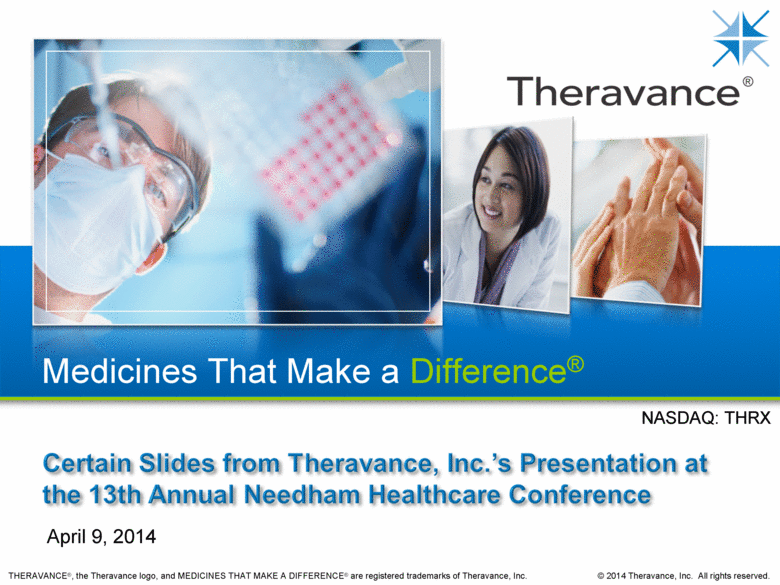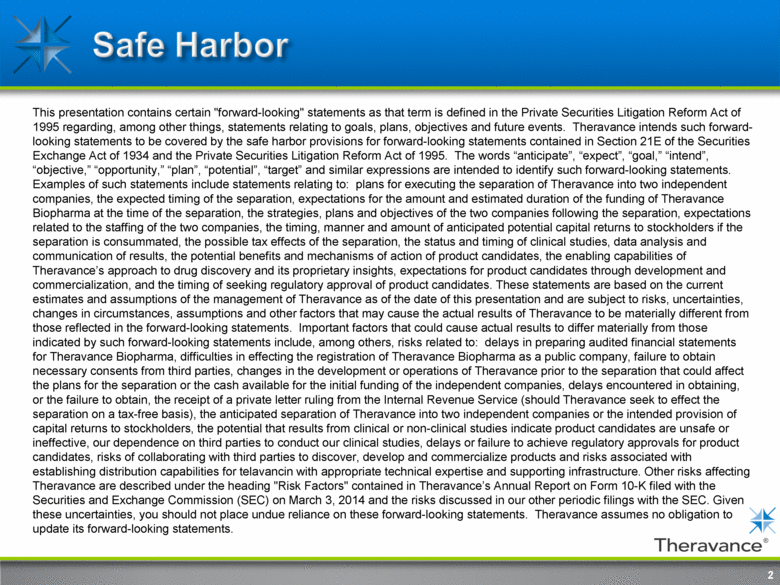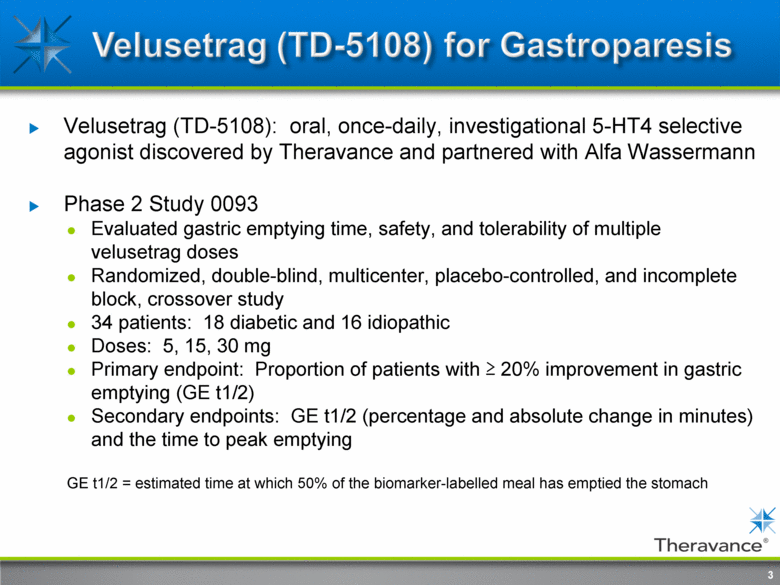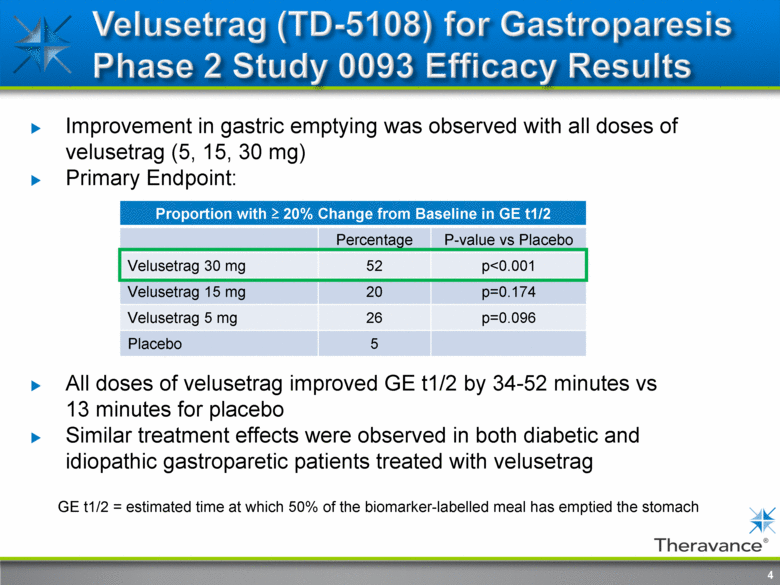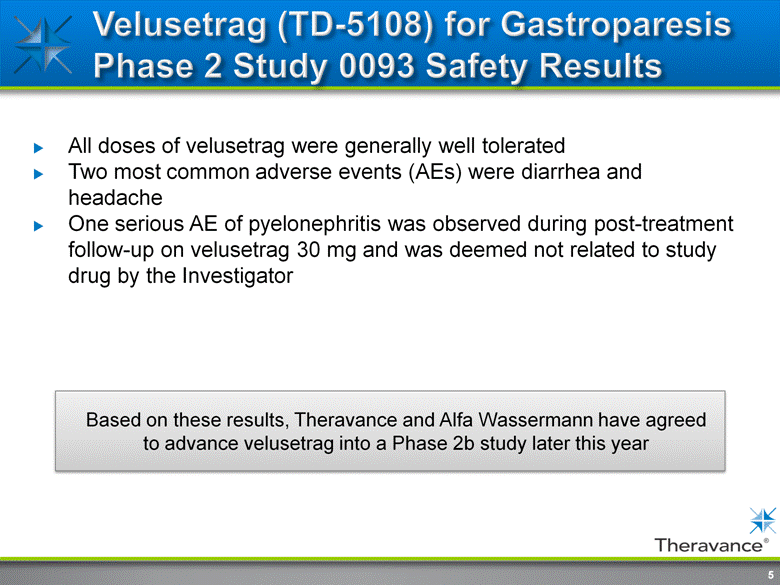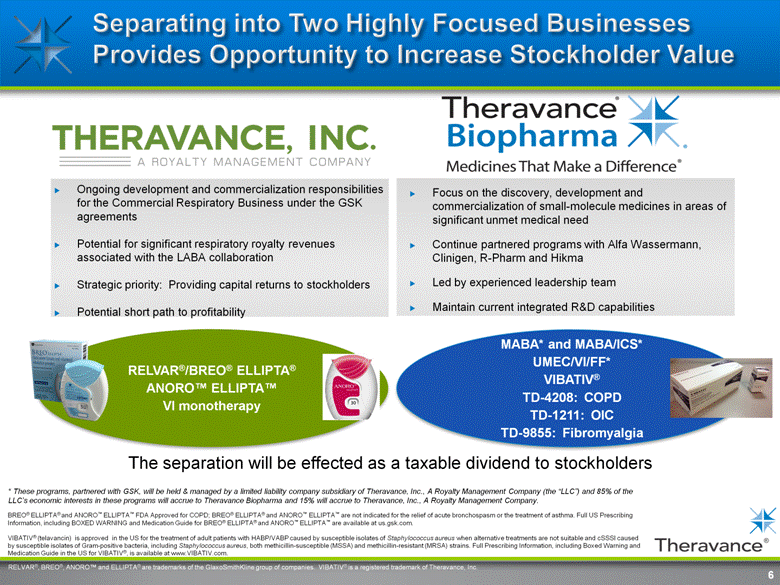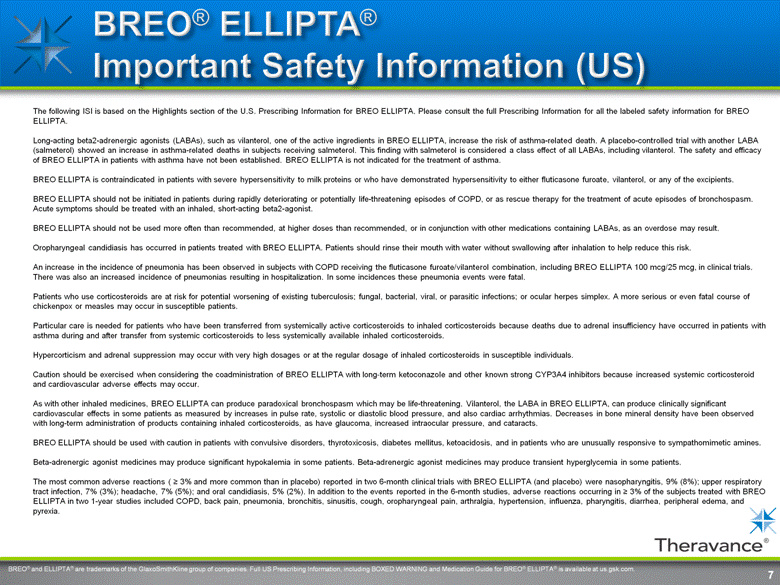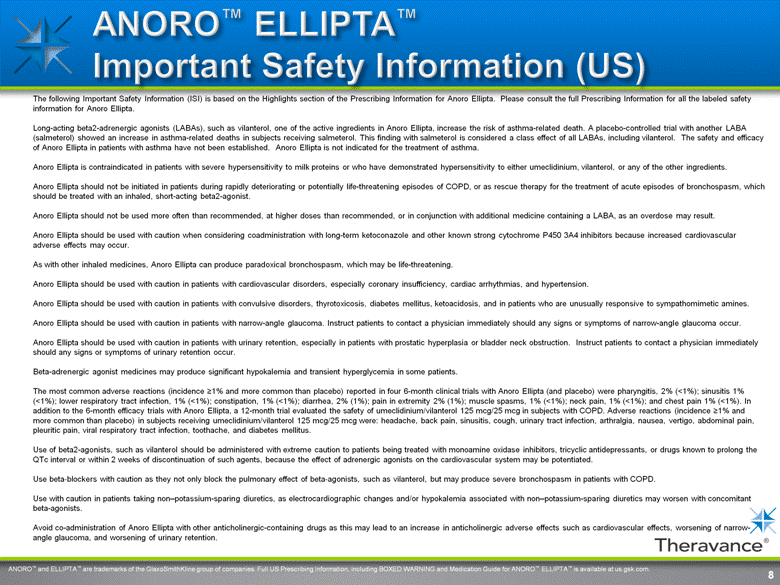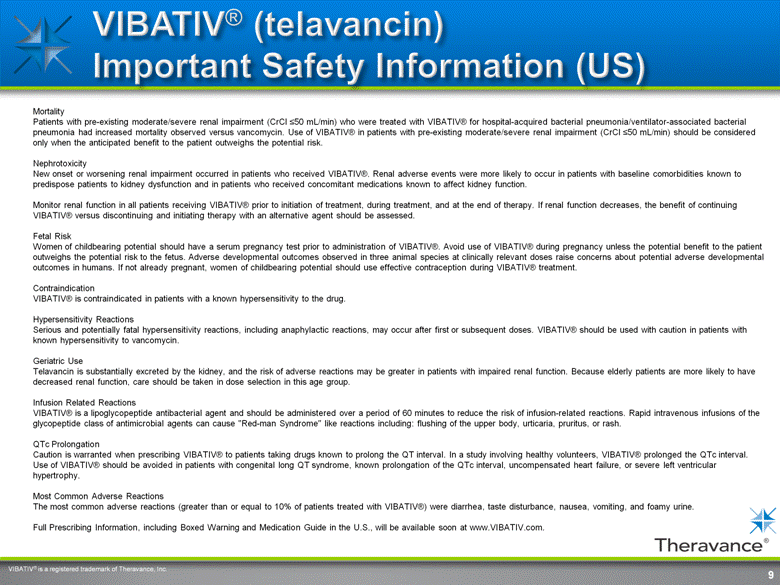Attached files
| file | filename |
|---|---|
| 8-K - 8-K - Innoviva, Inc. | a14-10238_18k.htm |
Exhibit 99.1
|
|
April 9, 2014 NASDAQ: THRX Certain Slides from Theravance, Inc.’s Presentation at the 13th Annual Needham Healthcare Conference THERAVANCE®, the Theravance logo, and MEDICINES THAT MAKE A DIFFERENCE® are registered trademarks of Theravance, Inc. © 2014 Theravance, Inc. All rights reserved. |
|
|
This presentation contains certain "forward-looking" statements as that term is defined in the Private Securities Litigation Reform Act of 1995 regarding, among other things, statements relating to goals, plans, objectives and future events. Theravance intends such forward-looking statements to be covered by the safe harbor provisions for forward-looking statements contained in Section 21E of the Securities Exchange Act of 1934 and the Private Securities Litigation Reform Act of 1995. The words “anticipate”, “expect”, “goal,” “intend”, “objective,” “opportunity,” “plan”, “potential”, “target” and similar expressions are intended to identify such forward-looking statements. Examples of such statements include statements relating to: plans for executing the separation of Theravance into two independent companies, the expected timing of the separation, expectations for the amount and estimated duration of the funding of Theravance Biopharma at the time of the separation, the strategies, plans and objectives of the two companies following the separation, expectations related to the staffing of the two companies, the timing, manner and amount of anticipated potential capital returns to stockholders if the separation is consummated, the possible tax effects of the separation, the status and timing of clinical studies, data analysis and communication of results, the potential benefits and mechanisms of action of product candidates, the enabling capabilities of Theravance’s approach to drug discovery and its proprietary insights, expectations for product candidates through development and commercialization, and the timing of seeking regulatory approval of product candidates. These statements are based on the current estimates and assumptions of the management of Theravance as of the date of this presentation and are subject to risks, uncertainties, changes in circumstances, assumptions and other factors that may cause the actual results of Theravance to be materially different from those reflected in the forward-looking statements. Important factors that could cause actual results to differ materially from those indicated by such forward-looking statements include, among others, risks related to: delays in preparing audited financial statements for Theravance Biopharma, difficulties in effecting the registration of Theravance Biopharma as a public company, failure to obtain necessary consents from third parties, changes in the development or operations of Theravance prior to the separation that could affect the plans for the separation or the cash available for the initial funding of the independent companies, delays encountered in obtaining, or the failure to obtain, the receipt of a private letter ruling from the Internal Revenue Service (should Theravance seek to effect the separation on a tax-free basis), the anticipated separation of Theravance into two independent companies or the intended provision of capital returns to stockholders, the potential that results from clinical or non-clinical studies indicate product candidates are unsafe or ineffective, our dependence on third parties to conduct our clinical studies, delays or failure to achieve regulatory approvals for product candidates, risks of collaborating with third parties to discover, develop and commercialize products and risks associated with establishing distribution capabilities for telavancin with appropriate technical expertise and supporting infrastructure. Other risks affecting Theravance are described under the heading "Risk Factors" contained in Theravance’s Annual Report on Form 10-K filed with the Securities and Exchange Commission (SEC) on March 3, 2014 and the risks discussed in our other periodic filings with the SEC. Given these uncertainties, you should not place undue reliance on these forward-looking statements. Theravance assumes no obligation to update its forward-looking statements. 2 |
|
|
Velusetrag (TD-5108): oral, once-daily, investigational 5-HT4 selective agonist discovered by Theravance and partnered with Alfa Wassermann Phase 2 Study 0093 Evaluated gastric emptying time, safety, and tolerability of multiple velusetrag doses Randomized, double-blind, multicenter, placebo-controlled, and incomplete block, crossover study 34 patients: 18 diabetic and 16 idiopathic Doses: 5, 15, 30 mg Primary endpoint: Proportion of patients with ≥ 20% improvement in gastric emptying (GE t1/2) Secondary endpoints: GE t1/2 (percentage and absolute change in minutes) and the time to peak emptying GE t1/2 = estimated time at which 50% of the biomarker-labelled meal has emptied the stomach 3 |
|
|
Improvement in gastric emptying was observed with all doses of velusetrag (5, 15, 30 mg) Primary Endpoint: All doses of velusetrag improved GE t1/2 by 34-52 minutes vs 13 minutes for placebo Similar treatment effects were observed in both diabetic and idiopathic gastroparetic patients treated with velusetrag 4 Proportion with ≥ 20% Change from Baseline in GE t1/2 Percentage P-value vs Placebo Velusetrag 30 mg 52 p<0.001 Velusetrag 15 mg 20 p=0.174 Velusetrag 5 mg 26 p=0.096 Placebo 5 GE t1/2 = estimated time at which 50% of the biomarker-labelled meal has emptied the stomach |
|
|
All doses of velusetrag were generally well tolerated Two most common adverse events (AEs) were diarrhea and headache One serious AE of pyelonephritis was observed during post-treatment follow-up on velusetrag 30 mg and was deemed not related to study drug by the Investigator 5 Based on these results, Theravance and Alfa Wassermann have agreed to advance velusetrag into a Phase 2b study later this year |
|
|
BREO® ELLIPTA® and ANORO™ ELLIPTA™ FDA Approved for COPD; BREO® ELLIPTA® and ANORO™ ELLIPTA™ are not indicated for the relief of acute bronchospasm or the treatment of asthma. Full US Prescribing Information, including BOXED WARNING and Medication Guide for BREO® ELLIPTA® and ANORO™ ELLIPTA™ are available at us.gsk.com. VIBATIV® (telavancin) is approved in the US for the treatment of adult patients with HABP/VABP caused by susceptible isolates of Staphylococcus aureus when alternative treatments are not suitable and cSSSI caused by susceptible isolates of Gram-positive bacteria, including Staphylococcus aureus, both methicillin-susceptible (MSSA) and methicillin-resistant (MRSA) strains. Full Prescribing Information, including Boxed Warning and Medication Guide in the US for VIBATIV®, is available at www.VIBATIV.com. Ongoing development and commercialization responsibilities for the Commercial Respiratory Business under the GSK agreements Potential for significant respiratory royalty revenues associated with the LABA collaboration Strategic priority: Providing capital returns to stockholders Potential short path to profitability 6 RELVAR®/BREO® ELLIPTA® ANORO™ ELLIPTA™ VI monotherapy The separation will be effected as a taxable dividend to stockholders 6 MABA* and MABA/ICS* UMEC/VI/FF* VIBATIV® TD-4208: COPD TD-1211: OIC TD-9855: Fibromyalgia RELVAR®, BREO®, ANORO™ and ELLIPTA® are trademarks of the GlaxoSmithKline group of companies. VIBATIV® is a registered trademark of Theravance, Inc. Focus on the discovery, development and commercialization of small-molecule medicines in areas of significant unmet medical need Continue partnered programs with Alfa Wassermann, Clinigen, R-Pharm and Hikma Led by experienced leadership team Maintain current intergrated R&D capabilities |
|
|
7 The following ISI is based on the Highlights section of the U.S. Prescribing Information for BREO ELLIPTA. Please consult the full Prescribing Information for all the labeled safety information for BREO ELLIPTA. Long-acting beta2-adrenergic agonists (LABAs), such as vilanterol, one of the active ingredients in BREO ELLIPTA, increase the risk of asthma-related death. A placebo-controlled trial with another LABA (salmeterol) showed an increase in asthma-related deaths in subjects receiving salmeterol. This finding with salmeterol is considered a class effect of all LABAs, including vilanterol. The safety and efficacy of BREO ELLIPTA in patients with asthma have not been established. BREO ELLIPTA is not indicated for the treatment of asthma. BREO ELLIPTA is contraindicated in patients with severe hypersensitivity to milk proteins or who have demonstrated hypersensitivity to either fluticasone furoate, vilanterol, or any of the excipients. BREO ELLIPTA should not be initiated in patients during rapidly deteriorating or potentially life-threatening episodes of COPD, or as rescue therapy for the treatment of acute episodes of bronchospasm. Acute symptoms should be treated with an inhaled, short-acting beta2-agonist. BREO ELLIPTA should not be used more often than recommended, at higher doses than recommended, or in conjunction with other medications containing LABAs, as an overdose may result. Oropharyngeal candidiasis has occurred in patients treated with BREO ELLIPTA. Patients should rinse their mouth with water without swallowing after inhalation to help reduce this risk. An increase in the incidence of pneumonia has been observed in subjects with COPD receiving the fluticasone furoate/vilanterol combination, including BREO ELLIPTA 100 mcg/25 mcg, in clinical trials. There was also an increased incidence of pneumonias resulting in hospitalization. In some incidences these pneumonia events were fatal. Patients who use corticosteroids are at risk for potential worsening of existing tuberculosis; fungal, bacterial, viral, or parasitic infections; or ocular herpes simplex. A more serious or even fatal course of chickenpox or measles may occur in susceptible patients. Particular care is needed for patients who have been transferred from systemically active corticosteroids to inhaled corticosteroids because deaths due to adrenal insufficiency have occurred in patients with asthma during and after transfer from systemic corticosteroids to less systemically available inhaled corticosteroids. Hypercorticism and adrenal suppression may occur with very high dosages or at the regular dosage of inhaled corticosteroids in susceptible individuals. Caution should be exercised when considering the coadministration of BREO ELLIPTA with long‐term ketoconazole and other known strong CYP3A4 inhibitors because increased systemic corticosteroid and cardiovascular adverse effects may occur. As with other inhaled medicines, BREO ELLIPTA can produce paradoxical bronchospasm which may be life-threatening. Vilanterol, the LABA in BREO ELLIPTA, can produce clinically significant cardiovascular effects in some patients as measured by increases in pulse rate, systolic or diastolic blood pressure, and also cardiac arrhythmias. Decreases in bone mineral density have been observed with long-term administration of products containing inhaled corticosteroids, as have glaucoma, increased intraocular pressure, and cataracts. BREO ELLIPTA should be used with caution in patients with convulsive disorders, thyrotoxicosis, diabetes mellitus, ketoacidosis, and in patients who are unusually responsive to sympathomimetic amines. Beta-adrenergic agonist medicines may produce significant hypokalemia in some patients. Beta-adrenergic agonist medicines may produce transient hyperglycemia in some patients. The most common adverse reactions ( ≥ 3% and more common than in placebo) reported in two 6-month clinical trials with BREO ELLIPTA (and placebo) were nasopharyngitis, 9% (8%); upper respiratory tract infection, 7% (3%); headache, 7% (5%); and oral candidiasis, 5% (2%). In addition to the events reported in the 6-month studies, adverse reactions occurring in ≥ 3% of the subjects treated with BREO ELLIPTA in two 1-year studies included COPD, back pain, pneumonia, bronchitis, sinusitis, cough, oropharyngeal pain, arthralgia, hypertension, influenza, pharyngitis, diarrhea, peripheral edema, and pyrexia. BREO® and ELLIPTA® are trademarks of the GlaxoSmithKline group of companies. Full US Prescribing Information, including BOXED WARNING and Medication Guide for BREO® ELLIPTA® is available at us.gsk.com. |
|
|
8 The following Important Safety Information (ISI) is based on the Highlights section of the Prescribing Information for Anoro Ellipta. Please consult the full Prescribing Information for all the labeled safety information for Anoro Ellipta. Long-acting beta2-adrenergic agonists (LABAs), such as vilanterol, one of the active ingredients in Anoro Ellipta, increase the risk of asthma-related death. A placebo-controlled trial with another LABA (salmeterol) showed an increase in asthma-related deaths in subjects receiving salmeterol. This finding with salmeterol is considered a class effect of all LABAs, including vilanterol. The safety and efficacy of Anoro Ellipta in patients with asthma have not been established. Anoro Ellipta is not indicated for the treatment of asthma. Anoro Ellipta is contraindicated in patients with severe hypersensitivity to milk proteins or who have demonstrated hypersensitivity to either umeclidinium, vilanterol, or any of the other ingredients. Anoro Ellipta should not be initiated in patients during rapidly deteriorating or potentially life-threatening episodes of COPD, or as rescue therapy for the treatment of acute episodes of bronchospasm, which should be treated with an inhaled, short-acting beta2-agonist. Anoro Ellipta should not be used more often than recommended, at higher doses than recommended, or in conjunction with additional medicine containing a LABA, as an overdose may result. Anoro Ellipta should be used with caution when considering coadministration with long-term ketoconazole and other known strong cytochrome P450 3A4 inhibitors because increased cardiovascular adverse effects may occur. As with other inhaled medicines, Anoro Ellipta can produce paradoxical bronchospasm, which may be life-threatening. Anoro Ellipta should be used with caution in patients with cardiovascular disorders, especially coronary insufficiency, cardiac arrhythmias, and hypertension. Anoro Ellipta should be used with caution in patients with convulsive disorders, thyrotoxicosis, diabetes mellitus, ketoacidosis, and in patients who are unusually responsive to sympathomimetic amines. Anoro Ellipta should be used with caution in patients with narrow-angle glaucoma. Instruct patients to contact a physician immediately should any signs or symptoms of narrow-angle glaucoma occur. Anoro Ellipta should be used with caution in patients with urinary retention, especially in patients with prostatic hyperplasia or bladder neck obstruction. Instruct patients to contact a physician immediately should any signs or symptoms of urinary retention occur. Beta-adrenergic agonist medicines may produce significant hypokalemia and transient hyperglycemia in some patients. The most common adverse reactions (incidence ≥1% and more common than placebo) reported in four 6-month clinical trials with Anoro Ellipta (and placebo) were pharyngitis, 2% (<1%); sinusitis 1% (<1%); lower respiratory tract infection, 1% (<1%); constipation, 1% (<1%); diarrhea, 2% (1%); pain in extremity 2% (1%); muscle spasms, 1% (<1%); neck pain, 1% (<1%); and chest pain 1% (<1%). In addition to the 6-month efficacy trials with Anoro Ellipta, a 12-month trial evaluated the safety of umeclidinium/vilanterol 125 mcg/25 mcg in subjects with COPD. Adverse reactions (incidence ≥1% and more common than placebo) in subjects receiving umeclidinium/vilanterol 125 mcg/25 mcg were: headache, back pain, sinusitis, cough, urinary tract infection, arthralgia, nausea, vertigo, abdominal pain, pleuritic pain, viral respiratory tract infection, toothache, and diabetes mellitus. Use of beta2-agonists, such as vilanterol should be administered with extreme caution to patients being treated with monoamine oxidase inhibitors, tricyclic antidepressants, or drugs known to prolong the QTc interval or within 2 weeks of discontinuation of such agents, because the effect of adrenergic agonists on the cardiovascular system may be potentiated. Use beta‐blockers with caution as they not only block the pulmonary effect of beta‐agonists, such as vilanterol, but may produce severe bronchospasm in patients with COPD. Use with caution in patients taking non–potassium-sparing diuretics, as electrocardiographic changes and/or hypokalemia associated with non–potassium-sparing diuretics may worsen with concomitant beta-agonists. Avoid co-administration of Anoro Ellipta with other anticholinergic-containing drugs as this may lead to an increase in anticholinergic adverse effects such as cardiovascular effects, worsening of narrow-angle glaucoma, and worsening of urinary retention. ANORO™ and ELLIPTA™ are trademarks of the GlaxoSmithKline group of companies. Full US Prescribing Information, including BOXED WARNING and Medication Guide for ANORO™ ELLIPTA™ is available at us.gsk.com. |
|
|
9 Mortality Patients with pre-existing moderate/severe renal impairment (CrCl ≤50 mL/min) who were treated with VIBATIV® for hospital-acquired bacterial pneumonia/ventilator-associated bacterial pneumonia had increased mortality observed versus vancomycin. Use of VIBATIV® in patients with pre-existing moderate/severe renal impairment (CrCl ≤50 mL/min) should be considered only when the anticipated benefit to the patient outweighs the potential risk. Nephrotoxicity New onset or worsening renal impairment occurred in patients who received VIBATIV®. Renal adverse events were more likely to occur in patients with baseline comorbidities known to predispose patients to kidney dysfunction and in patients who received concomitant medications known to affect kidney function. Monitor renal function in all patients receiving VIBATIV® prior to initiation of treatment, during treatment, and at the end of therapy. If renal function decreases, the benefit of continuing VIBATIV® versus discontinuing and initiating therapy with an alternative agent should be assessed. Fetal Risk Women of childbearing potential should have a serum pregnancy test prior to administration of VIBATIV®. Avoid use of VIBATIV® during pregnancy unless the potential benefit to the patient outweighs the potential risk to the fetus. Adverse developmental outcomes observed in three animal species at clinically relevant doses raise concerns about potential adverse developmental outcomes in humans. If not already pregnant, women of childbearing potential should use effective contraception during VIBATIV® treatment. Contraindication VIBATIV® is contraindicated in patients with a known hypersensitivity to the drug. Hypersensitivity Reactions Serious and potentially fatal hypersensitivity reactions, including anaphylactic reactions, may occur after first or subsequent doses. VIBATIV® should be used with caution in patients with known hypersensitivity to vancomycin. Geriatric Use Telavancin is substantially excreted by the kidney, and the risk of adverse reactions may be greater in patients with impaired renal function. Because elderly patients are more likely to have decreased renal function, care should be taken in dose selection in this age group. Infusion Related Reactions VIBATIV® is a lipoglycopeptide antibacterial agent and should be administered over a period of 60 minutes to reduce the risk of infusion-related reactions. Rapid intravenous infusions of the glycopeptide class of antimicrobial agents can cause "Red-man Syndrome" like reactions including: flushing of the upper body, urticaria, pruritus, or rash. QTc Prolongation Caution is warranted when prescribing VIBATIV® to patients taking drugs known to prolong the QT interval. In a study involving healthy volunteers, VIBATIV® prolonged the QTc interval. Use of VIBATIV® should be avoided in patients with congenital long QT syndrome, known prolongation of the QTc interval, uncompensated heart failure, or severe left ventricular hypertrophy. Most Common Adverse Reactions The most common adverse reactions (greater than or equal to 10% of patients treated with VIBATIV®) were diarrhea, taste disturbance, nausea, vomiting, and foamy urine. Full Prescribing Information, including Boxed Warning and Medication Guide in the U.S., will be available soon at www.VIBATIV.com. VIBATIV® is a registered trademark of Theravance, Inc. |

